-

人教版高中政治必修3传统文化的继承说课稿
只有对儒家的价值作出客观、公正、全面的评价,才可能避免陷入文化虚无主义或文化复古主义的误区,合理地、充分地开发利用儒学乃至整个国学的资源为现代社会服务,为促进我国经济发展服务。运用所学知识,谈谈对待儒学我们应该持有的态度。答案:(1)儒学是我国传统文化中一个非常重要的组成部分。传统文化具有相对稳定性,它的内涵又能够因时而变,因此,我们对待儒学的正确态度应该是“取其精华,去其糟粕,批判继承,古为今用”。(2)面对儒学,我们要辩证地认识它在现实生活中的作用,分辨其中的精华和糟粕。对于其中符合社会发展要求的、积极向上的内容,应该继续保持和发扬,使其为社会主义现代化建设服务;对于其中不符合社会发展要求的、落后的、腐朽的东西,必须“移风易俗”,自觉地加以改造和剔除。(五)作业布置传统文化的作用是什么?如何正确对待传统文化?
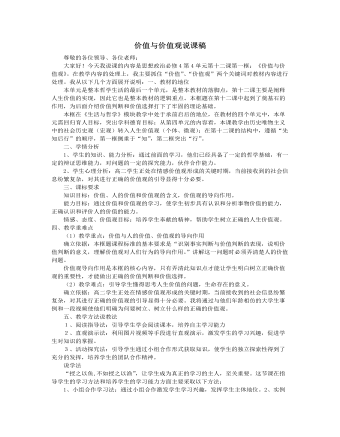
人教版高中政治必修4价值与价值观说课稿(一)
预测回答:成龙在影视,武术方面的价值,对于某个人,某个集团的价值。知识引导:人的价值体现在多方面的,可以是物质方面,也可以是精神方面,可以是对某个人或某个集团的价值,也可以是对人类和社会的价值。设置目的:从学生感兴趣的人物入手,分析对人的价值的评价。让学生自己分析总结,体现学生在新课改下的主体地位。从上述事例中我们可以看出人的价值是什么?如何评价?(学生活动)2.人的价值:在于创造价值,在于对社会的责任和贡献,即通过自己的活动满足自己所属的社会、他人以及自己的需要。(幻灯片显示)3.人的价值评价:看他的贡献,最根本的是对社会发展和人类进步事业的贡献。(幻灯片显示)老师总结:对社会的贡献并不是高高在上,不可触及。只要是做自己该做的事,从身边的小事做起,普普通通的劳动就是贡献社会和他人。学生归纳:人生价值原理二、价值观的导向作用(板书)1.价值观的含义人们在认识各种具体事物的价值的基础上,形成对事物价值的总的看法和根本观点。
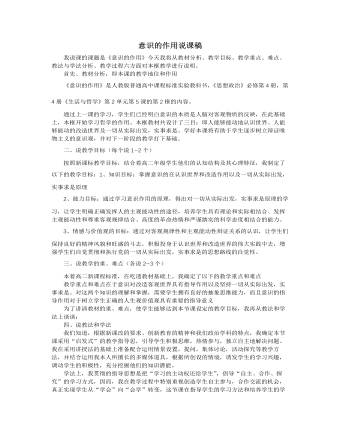
人教版高中政治必修4意识的作用说课稿(一)
1、课题引入:我设计以提问哲学到底是什么?的问题激发学生的阅读兴趣。我设计典型事例,通过学生讨论,教师总结的形式,并得出其实哲学就在我们身边。2、讲授新课:(35分钟)通过教材第一目的讲解,让学生明白,生活和学习中有许多蕴涵哲学道理的故事,表明哲学并不神秘总结并过渡:生活也离不开哲学,哲学可以是我正确看待自然、人生、和社会的发展,从而指导人们正确的认识和改造世界。整个过程将伴随着多媒体影像资料和生生对话讨论以提高学生的积极性。3、课堂反馈,知识迁移。最后对本科课进行小结,巩固重点难点,将本课的哲学知识迁移到与生活相关的例子,实现对知识的升华以及学生的再次创新;可使学生更深刻地理解重点和难点,为下一框学习做好准备。

人教版高中英语必修1English around the world说课稿
(3)v. 给:提出;展现,显现present sb. with sth. ; present sth. to sb. 把. . 交给;颁发;授予present sth. (for sth. )/present sth. to sb. e. g. Om his birthday, his friends presented him a collection of stamps. 在他生日时,他的朋友们送给他一套邮票作为礼物。The sword was presented by the family to the museum. 这家人把宝剑捐赠给了博物馆。The committee will present the final report to Parliament in June. 委员会将在六月向议会提交最后的报告。You need to present yourself better. 你需要更善于展现自己。It is essential that we present a united front. 至关重要的是我们要表现得更加团结。Step 4 ConsolidationT:Now that we have got a general idea of these words and phrases. Lets make up some sentences using them to master them. Suggested sentences:1. Your duties include typing letters and answering the telephone. 2. It is one of the greatest roles that she has played. 3. A large number of people have applied for the job. 4. The number of the panda is declining. 5. I'11 go there, even if I have to walk. 6. He came up to me to ask for a light. 7. The novel is about a family who can't communicate with each other. 8. He based his plan on interests of most people. 9. Why doesn't he make use of his singing talent?Step 5 Summary and homeworkT:Today we dealt with several new words and phrases. After class I hope that youcan read them again and again to keep them in mind. That's all for today. You aredismissed.

人教版高中英语必修2Cultural Relics说课稿2篇
Ⅲ. Analysis of the teaching material:The topic of this unit is cultural relics. Students are quite interested in topics about different cultures around the world. This is the second period of the whole unit. As a reading class, the passage mainly talks about the history of the amber room (how it was made, sent as a gift, lost and rebuilt).According to the new national curriculum, when teaching reading, much emphasis should be put on training the students’ reading skills.Ⅳ. Teaching objectives1. Language objectives:1) Students are required to master the key words and phrases occurred in the passage (e.g. amazing, decorate, belong, in return, less than etc.)2) Students are required to learn the attributive clause and acquire the sentence pattern.2. 1) Students are required to describe a certain thing by using the new sentence patterns.2) Students are required to master two kinds of reading skills—skimming and scanning, and learn to use them in their daily reading.3. 1) Students are required to know the history of the amber room.2) Students are required to appreciate cultural relics and understand the importance of protecting them.Ⅴ. Teaching important and difficult points1) the new words, phrases, and sentence pattern in the course of reading.2) Teaching difficult point: Help the students master two kinds of reading skills—skimmingand scanning and learn to apply them in daily use.Ⅵ. Teaching methods:Task-based method & Top-down model Ⅶ. Teaching aids: PPT, pictures, blackboard Ⅷ. Teaching procedure:

人教版高中英语必修2Wildlife Protection说课稿3篇
When it comes to the students’ studying methods, I'd like to introduce my Ss first. The Ss have a good command of basic language points. They’re interested in learning English, and they take an active part in English class, so they will have fun in autonomous, cooperative and inquiry learning. I will just serve as a guide, showing them the way to explore how to make more progress in their English learning.Now it’s time for the most important stage of this lesson. My teaching procedures are arranged as follows:Step1.Leading-in (3 minute)Play a video of a wide variety of wildlife to introduce my topic. Step2. Speaking (12 minutes)We will use our textbook Page25. Let the Ss fast read the short paragraph to warm up. Ask them to talk about the report on some endangered wildlife in China with the dialogue patterns on the screen. Lastly, I will invite some groups to demonstrate their dialogues about saving wildlife in China.Step3.English play (3 minutes)Watch another video in praise of their excellent performance just now. It’s about Jack Chen’s(成龙)and Yang Ziqiong’s wildlife protection.Step4. Listening (twice 13 minutes)This time, I’ll ask the Ss to fill in the blanks of the monologue of the 2 movie stars above. Step5.Discussion (3 minutes)Which would you like to choose to wear, clothes made of cotton, artificial leather or animal skins? Why ?Step6. Summary (3 minutes)1. If there were no wildlife, there wouldn’t exist human beings. If the buying stops, the killing can, too.2. Animals are our friends. To love animals is to love ourselves. Stop hunting, killing and destroying wildlife.3. Let’s live in harmony with all the living things in the world. Step7. Music appreciation (3 minutes)Let the Ss appreciate the song Earth Song by Michael Jackson. Last but not the least, I will show you my blackboard design.

人教版高中英语必修4Women of achievement说课稿4篇
Good morning, distinguished judges:It’s my honor to talk about my teaching ideas with you. Today my topic is Women of Achievement. My presentation consists of six parts: the analysis of teaching material and student, teaching aims, key and difficult points, teaching and studying method, teaching procedures and blackboard design.First, let’s focus on the analysis of teaching material. This lesson is from New Senior English for China Student’s Book 4 Unit 1, the reading part. The main topic of the passage is the introduction of a student of Africanwildlife. After this lesson, the students will learn more information about her studying chimps in Africa, and their reading and speaking abilities can be developed as well.The next part is the analysis of students. My students are in senior high students. They have learnt English for many years, they’ve known many words and sentences, but their speaking and reading abilities are still not very good. So I will practice their speaking and reading abilities through different exercises.According to the New Standard Curriculum and the present situation, I set the teaching aims as follows: firstly, knowledge aims. Students can grasp some new words, such as worthwhile, move off. Moreover, students can understand the content of the passage and get familiar with the topic of studying chimps in wildlife. Secondly, ability aims. Students can use reading strategies such as skimming and scanning in reading process. Thirdly, emotional aims. Students can have the awareness of protecting animals and care about animals.Based on the above analysis, the key point of this lesson is to get the main idea and the detailed information from the passage; the difficult point is to talk about the wildlife protection and use reading strategies.

人教版高中英语必修3Healthy Eating说课稿4篇
Language learning needs a context, which can help the learners to understand the language and then can product comprehensible output, so computer has the advantages to make the materials attractive.Part 3 Learning MethodsTask-based, self-dependent and cooperative learningPart 4 Teaching ProcedureStep One Lead-in“Interest is the best teacher.” Therefore, at the very beginning of the class, I should spark the students’ mind to focus on the centre topic “the band”. I’ll show some pictures of food to attract their attention and then bring some questions.Question:What kind of food they like?What should go into a good meal?The answers must relate to the diet. After this, the students will be eager to know something about a balance diet and this is the very time to naturally lead the class into Step 2Step 2 Reading for information: skimming and scanning In this step, I use Task-based Language Teaching method, which can give students a clear and specific purpose while skimming and scanning the context.Task 1 General ideaThe students will be asked to just glance at the title and the pictures of the passage, and then guess what they will read in the text. And they’ll be divided into groups of four to have a discussion.The purpose is to inspire the students to read actively, not passively. In addition, the task is to develop the students’ reading skill by making prediction and to encourage the students to express their thoughts in English and cooperate with each other.Task 2 Main idea of each paragraphCooperative learning can raise the students’ interest and create an atmosphere of achievement. Based on this theory, I divide the whole class into 4 groups to skim the whole text and get the main idea of each paragraph.

人教版高中英语必修5First aid说课稿6篇
In this class, I have 3 teaching aims, that is, knowledge aims, ability aims and emotion aims.1) Knowledge-Teach students new words and expressions, such as temporary, bleed,sprain choke, first aid, fall ill and so on.-Enable students to have a better understanding for some basic knowledge of first aid.2) Ability-Train students’ speaking, reading and writing abilities by different teaching activities, such as skimming, comprehending, team work, role play, retelling and writing.-Develop students’ reading strategy on how to move general idea to specific information.3) Emotion-Promote students’ awareness of giving first aid.- Cultivate students’ creativities.Then let’s come to my teaching methods and activities.III. Teaching methods and activities:To achieve different teaching aims, various kinds of teaching methods and activities will be adopted throughout this period, such as TBL (task-based learning), skimming, team work, brainstorm and others, which can offer students opportunities to fulfill tasks in which they can use language to achieve a specific outcome.IV. Teaching aids:Computer and blackboardV. Teaching important points:1) Make students have a clear mind for the structure of the text.2) Help students understand the theme of the text.VI. Teaching difficulties:1) So many new words may affect students’ understanding.2) How to get students to know about the functions of the skin and thecauses, characteristics and treatments for different degree burns,and the knowledge about giving first aid. VII. Blackboard design:

人教版高中英语必修5Making the news说课稿4篇
今天我们来介绍一下必修五第四单元的授课方式。这个单元的题目是Making the news。应该是学生比较感兴趣的话题,学生往往对新闻工作充满好奇,所以我们可以利用这个机会多设计一些师生互动和学生互动,来激发起学习的积极性,提高学习效率。同时我们可以利用这个单元不仅帮助学生掌握语言知识,培养语言能力,同时让其了解新闻工作的重要性,培养起社会智能感。这个单元分为六个课时,它的教学目标是这样的:语言目标是掌握词汇表中的常用单词和短语,掌握倒装句的一些基本用法。 技能目标是能初步掌握约会的基本句型并在真实的场景下正确运用。新闻报道类文章的写作技能。采访的基本规范和沟通技能。情感目标是对新闻报道的客观性和真实性有更好的理解。对新闻记者的职业有更深入的了解,并能体会其工作的重要性。下面我们来介绍一下第一课时的授课方式,第一课的教学目标是这样的第一课时的教学目标语言目标:单词:Occupation, journalist, editor, photographer, curious, personality, enthusiasm
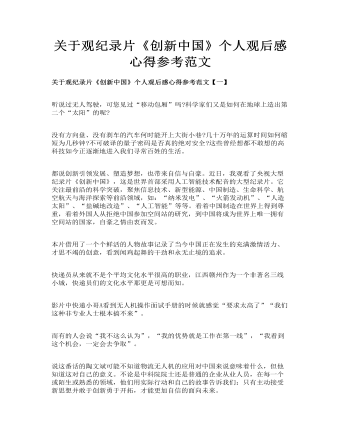
关于观纪录片《创新中国》个人观后感心得参考范文
都说创新引领发展、塑造梦想,也带来自信与自豪。近日,我观看了央视大型纪录片《创新中国》,这是世界首部采用人工智能技术配音的大型纪录片。它关注最前沿的科学突破,聚焦信息技术、新型能源、中国制造、生命科学、航空航天与海洋探索等前沿领域,如:“纳米发电”、“火箭发动机”、“人造太阳”、“盐碱地改造”、“人工智能”等等。看着中国制造在世界上得到尊重,看着外国人从拒绝中国参加空间站的研究,到中国将成为世界上唯一拥有空间站的国家,自豪之情由衷而发。

环境卫生和文明交通提升工程启动仪式上的发言讲话讲稿
虽然我们具备了创建全国文明城市的一定条件,但我们还要充分认识到全国文明城市是所有城市品牌中含金量最高、创建难度最大的一个,是最能反映城市整体文明水平的综合性荣誉称号。环境整洁、卫生清洁、交通文明是城市文明的最直接表现,是成功创文的重要保证。今天举办启动仪式的目的是明确目标,提振士气,提升信心,在今后工作中,还靠大家发扬“钉钉子精神”和“工匠精神”,敢于担当,敢于作为。借今天的机会,我想提三点意见,与大家一起共勉,携手共创全国文明城市:
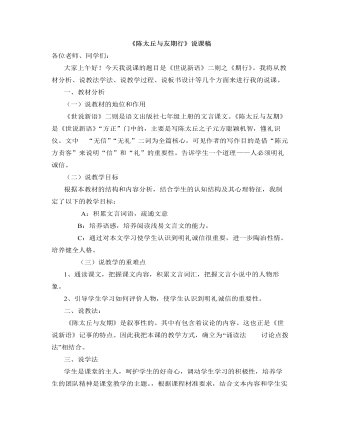
部编版语文七年级上册《陈太丘与友期行》说课稿
各位老师、同学们:大家上午好!今天我说课的题目是《世说新语》二则之《期行》。我将从教材分析、说教法学法、说教学过程、说板书设计等几个方面来进行我的说课。一、教材分析(一)说教材的地位和作用《世说新语》二则是语文出版社七年级上册的文言课文。《陈太丘与友期》是《世说新语》“方正”门中的,主要是写陈太丘之子元方聪颖机智,懂礼识仪。文中 “无信”“无礼”二词为全篇核心,可见作者的写作目的是借“陈元方责客”来说明“信”和“礼”的重要性。告诉学生一个道理——人必须明礼诚信。(二)说教学目标根据本教材的结构和内容分析,结合学生的认知结构及其心理特征,我制定了以下的教学目标:A:积累文言词语,疏通文意B:培养语感,培养阅读浅易文言文的能力。
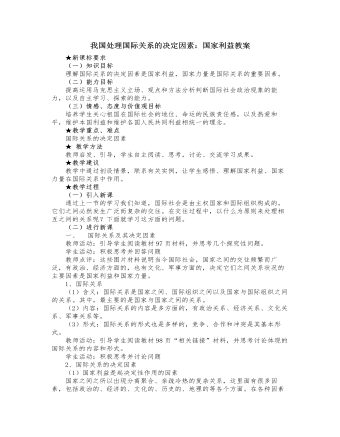
人教版高中政治必修2我国处理国际关系的决定因素:国家利益教案
从国际法角度看,国际社会的每一个主权国家应该是一律平等的,但是,在现实的国际关系中,每个国家的国际地位、国际影响力,历来都是由国家力量决定的。国家力量发生变化,也会引起国际关系的变化。经济、科技落后,军力不强,国内政局不安,它的国际影响力、参与力就不强。正因为如此,某些发达国家往往以其强大的国家力量为后盾,推行霸权主义、强权政治。二、维护我国的国家利益教师活动:阅读教材第100页内容,思考讨论为什么要维护我国的国家利益?我国的国家利益包括哪些内容?学生活动:认真思考并积极讨论,踊跃发言1、原因我国是人民当家作主的社会主义国家,国家利益与人民的根本利益相一致。维护我国的国家利益就是维护广大人民的根本利益,具有正当性和正义性。2、内容我国国家利益的主要内容包括:安全利益,如国家的统一、独立、主权和领土完整;政治利益,如我国政治、经济、文化等制度的巩固;经济利益,如我国资源利用的效益、经济活动的利益和国家物质基础的增强等。

人教版高中历史必修3建国以来的重大科技成就教案
思考:1)材料1、2反映了一个什么样的严重问题?(饥饿和粮食问题)2)材料3中,中国农民为什么那样说?(邓小平在全国实行的以家庭联产承包责任制为主要形式的责任制调动了农民生产的积极性,解放了农村生产力,推动了农业的发展;袁隆平的杂交水稻提高了水稻产量,增加了农民的收入,解决了农民的吃饭问题)3)据以上材料指出,袁隆平研究的交水稻有何重大意义?(杂交稻不仅解决了中国人的吃饭问题;而且其在世界范围的推广,也有助于解决世界性的饥饿问题)四、计算机技术与生物技术的发展1、20世纪50年代,我国开始了计算机的研制工作;2、1983年,我国成功研制出巨型计算机“银河-Ⅰ号”,加速了国家信息化的发展;3、1965年,中国首次人工合成结晶牛胰岛素(在世界上第一次用人工方法合成出具有生物活性的蛋白质——结晶牛胰岛素) 。4、积极参与人类基因的研究(唯一的发展中国家)。
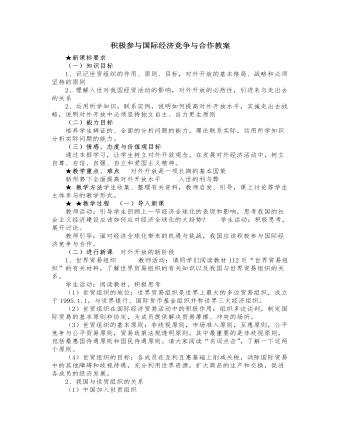
人教版高中政治必修1积极参与国际经济竞争与合作教案
学生活动:认真阅读,积极思考。教师总结:这样一个人口大国,依靠外国是不能解决温饱问题的,更谈不上社会主义现代化。实行对外开放,发展对外经济关系,必须坚持独立自主、自力更生原则,并以此为自己发展的根本基点。但坚持坚持独立自主、自力更生,并不是闭关自守、盲目排外,而是在立足自身基础上实行对外开放,把二者结合起来。(三)课堂总结、点评这节课我们重点学习了我国对外开放方面的有关知识,知道了在经济全球化的国际大趋势下,社会主义现代化建设必须实行对外开放,积极参与国际经济竞争与合作。了解了我国对外开放的成就、格局、新形势下的基本政策和战略。这对于我们在正确地认识国际经济关系,增强社会主义优越感和民族自强意识,自觉投身现代化建设等将有重大指导作用。
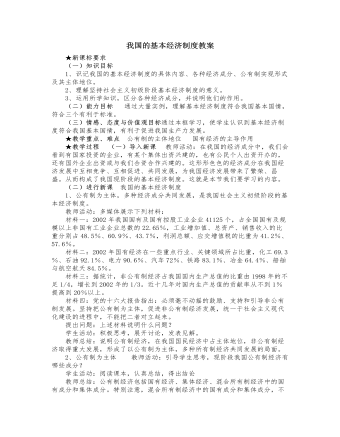
人教版高中政治必修1我国的基本经济制度教案
(3)外资经济 教师活动:外资经济是指外国投资者和港澳台投资者根据我国法律法规,在我国大陆设立的独资企业以及中外合资企业、中外合作企业中的外商投资部分。他有利于引进外资和先进技术,学习境外先进管理经验,有利于扩大就业、扩大出口,增加财政收入。 提醒学生注意中外合资企业、中外合作企业中的外商投资部分,不是指中外合资企业、中外合作企业全部资产。并简略介绍中外合资企业与中外合作企业的区别。(4)非公有制经济的地位 是社会主义市场经济的重要组成部分。教师点拨:请同学们注意比较,非公有制经济的地位与前面集体经济的地位有什么不同?学生活动:积极思考,回答问题教师点拨:集体经济的地位,是社会主义公有制经济的重要组成部分。社会主义公有制经济与社会主义市场经济这两个说法是不同的。(简单了解即可)4、为什么坚持以公有制为主体,多种所有制经济共同发展
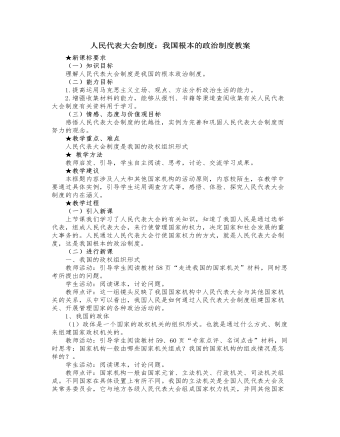
人教版高中政治必修2人民代表大会制度:我国根本的政治制度教案
二、适合我国国情的根本政治制度1、人民代表大会制度的主要内容国家的一切权力属于人民;人民在普选的基础上选举代表,组成各级人民代表大会作为国家权力机关;由国家权力机关产生其他国家机关,依法行使各自的职权;实行民主集中制的组织和活动原则等。2、为什么说人民代表大会制度是适合我国国情的根本政治制度(1)人民代表大会制度是由人民民主专政的社会主义国家性质决定的,是建立其他国家管理制度的基础,是中国社会主义民主政治最鲜明的特点。(2)人民代表大会制度以人民当家作主为宗旨,真正保证了人民群众参加国家管理,充分体现了人民的意志和利益。(3)实践证明,我国人民民主专政的国体和人民代表大会制度的政体,是中国人民奋斗的成果和历史的选择,是适合我国国情的政治制度。(4)建设社会主义民主政治,最重要的是坚持和完善人民代表大会制度,决不照搬西方的政治制度模式。

人教版高中政治必修2人民代表大会制度:我国根本的政治制度教案
(三)合作探究、精讲点拨一、我国的政权组织形式教师活动:引导学生阅读教材58页“走进我国的国家机关”材料,同时思考所提出的问题。学生活动:阅读课本,讨论问题。教师点评:这一组镜头反映了我国国家机构中人民代表大会与其他国家机关的关系,从中可以看出,我国人民是如何通过人民代表大会制度组建国家机关、开展管理国家的各种政治活动的。1、我国的政体(1)政体是一个国家的政权机关的组织形式。也就是通过什么方式、制度来组建国家政权机关的。教师活动:引导学生阅读教材59、60页“专家点评、名词点击”材料,同时思考:国家机构一般由哪些国家机关组成?我国的国家机构的组成情况是怎样的?。学生活动:阅读课本,讨论问题。教师点评:国家机构一般由国家元首、立法机关、行政机关、司法机关组成。不同国家在具体设置上有所不同。我国的立法机关是全国人民代表大会及其常务委员会,它与地方各级人民代表大会组成国家权力机关,并同其他国家机关共同组成我国的国家机构体系。
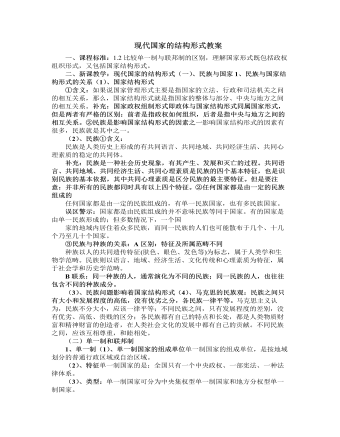
人教版高中政治选修3现代国家的结构形式教案
一、课程标准:1.2比较单一制与联邦制的区别,理解国家形式既包括政权组织形式,又包括国家结构形式。 二、新课教学:现代国家的结构形式(一)、民族与国家1、民族与国家结构形式的关系(1)、国家结构形式①含义:如果说国家管理形式主要是指国家的立法、行政和司法机关之问的相互关系,那么,国家结构形式就是指国家的整体与部分、中央与地方之间的相互关系。补充:国家政权组制形式即政体与国家结构形式同属国家形式,但是两者有严格的区别:前者是指政权如何组织,后者是指中央与地方之间的相互关系。②民族是影响国家结构形式的因素之一影响国家结构形式的因素有很多,民族就是其中之一。(2)、民族①含义:民族是人类历史上形成的有共同语言、共同地域、共同经济生活、共同心理素质的稳定的共同体。补充:民族是一种社会历史现象,有其产生、发展和灭亡的过程。

